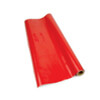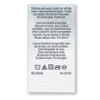Foil Application
Foil printing is a premium process that gives decorated items an attention-getting, metallic shimmer. It’s a highly efective way to add a bright accent to traditional screen printing or can be applied to large areas for maximum shine and impact. Foil printing involves screen printing a layer of adhesive onto the garment, curing the adhesive and then using heat and pressure to apply foil. It requires skill, attention and the right materials but achieves a special look with a high perceived value.
 IMAGE DESIGN: As with screen printing, create a customized graphic using professional graphics software. The graphic must be separated by color with each color – including the foil portion of the design – printed on its own clear positive film. Foil must be the top-most layer of the design, applied after all other ink has been applied and cured.
IMAGE DESIGN: As with screen printing, create a customized graphic using professional graphics software. The graphic must be separated by color with each color – including the foil portion of the design – printed on its own clear positive film. Foil must be the top-most layer of the design, applied after all other ink has been applied and cured. SCREEN MAKING: Using a darkroom and photographic chemicals, make a stencil – known as a screen – for each ink color and for the foil. For the foil screen, use a mesh with fine thread and high tension.
SCREEN MAKING: Using a darkroom and photographic chemicals, make a stencil – known as a screen – for each ink color and for the foil. For the foil screen, use a mesh with fine thread and high tension. ADHESIVE APPLICATION: Carefully position the foil screen in the screen printer. Using a squeegee with a hardness of about 75 shore, apply a 100-micron layer of viscous glue using two print and flood strokes. Angle the flood bar to ensure that the screen is well flooded and that the adhesive is pressed into the surface and not merely floating on top. Too little glue causes poor adhesion; too much will cause the glue to melt from under the foil, resulting in uneven edges. The printed glue should have a smooth, glass-like finish. Flash cure the glue as well as any underlying ink layers. You may also need to print a separation fluid to prevent the foil from adhering to inked areas other than the intended design. Dry time for regular plastisol is usually minimum 90 seconds at 165°C or 330°F. The polymerization of the ink that happens at 330°F after two seconds is usually enough, but we suggest using 90 seconds or more to be sure that the garment is heated up to the required temperature. Many ink suppliers use a temperature of 380°F to ensure that the plastisol is dry. However, that temperature may sometimes cause scorching or burning which could damage the print or fabric. You may print a grey layer of ink under a silver foil and a gold/yellow layer of ink under a golden foil, etc., or dye the glue grey or gold. Doing this means someone will not see that the foil is peeling or falling of of some pin spots after the first washes, and the image will look fresh for longer.
ADHESIVE APPLICATION: Carefully position the foil screen in the screen printer. Using a squeegee with a hardness of about 75 shore, apply a 100-micron layer of viscous glue using two print and flood strokes. Angle the flood bar to ensure that the screen is well flooded and that the adhesive is pressed into the surface and not merely floating on top. Too little glue causes poor adhesion; too much will cause the glue to melt from under the foil, resulting in uneven edges. The printed glue should have a smooth, glass-like finish. Flash cure the glue as well as any underlying ink layers. You may also need to print a separation fluid to prevent the foil from adhering to inked areas other than the intended design. Dry time for regular plastisol is usually minimum 90 seconds at 165°C or 330°F. The polymerization of the ink that happens at 330°F after two seconds is usually enough, but we suggest using 90 seconds or more to be sure that the garment is heated up to the required temperature. Many ink suppliers use a temperature of 380°F to ensure that the plastisol is dry. However, that temperature may sometimes cause scorching or burning which could damage the print or fabric. You may print a grey layer of ink under a silver foil and a gold/yellow layer of ink under a golden foil, etc., or dye the glue grey or gold. Doing this means someone will not see that the foil is peeling or falling of of some pin spots after the first washes, and the image will look fresh for longer. FOIL APPLICATION: Set your heat transfer press to the foil and ink manufacturers’ recommended time, temperature and pressure. Make certain that the hot plate is clean, the rubber pad is in good condition and that the press applies consistent pressure across the entire surface. Position the item in the heat transfer press, place the foil sheet over the adhesive-printed area and apply heat and pressure. Make several test prints to ensure that the foil is adhering smoothly and completely and that your design has sharp, even edges.
FOIL APPLICATION: Set your heat transfer press to the foil and ink manufacturers’ recommended time, temperature and pressure. Make certain that the hot plate is clean, the rubber pad is in good condition and that the press applies consistent pressure across the entire surface. Position the item in the heat transfer press, place the foil sheet over the adhesive-printed area and apply heat and pressure. Make several test prints to ensure that the foil is adhering smoothly and completely and that your design has sharp, even edges. LONGEVITY AND CARE: Foil printing is one of the least permanent decorating processes with a tendency to tarnish or flake after numerous washes. A quality printing job produces in a more durable result, and proper care can substantially increase the life of foil prints. Encourage your customers to turn foil printed items inside out before washing; launder using their washing machine’s delicate cycle or hand wash; hang to dry. Also let them know that they should never use an iron on a foil print.
LONGEVITY AND CARE: Foil printing is one of the least permanent decorating processes with a tendency to tarnish or flake after numerous washes. A quality printing job produces in a more durable result, and proper care can substantially increase the life of foil prints. Encourage your customers to turn foil printed items inside out before washing; launder using their washing machine’s delicate cycle or hand wash; hang to dry. Also let them know that they should never use an iron on a foil print.
Previous
Screen Printing
Next
Heat Transfer